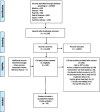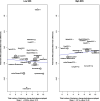The effectiveness of digital interventions for increasing physical activity in individuals of low socioeconomic status: a systematic review and meta-analysis
- PMID: 34753490
- PMCID: PMC8576797
- DOI: 10.1186/s12966-021-01218-4
The effectiveness of digital interventions for increasing physical activity in individuals of low socioeconomic status: a systematic review and meta-analysis
Abstract
Background: Digital technologies such as wearables, websites and mobile applications are increasingly used in interventions targeting physical activity (PA). Increasing access to such technologies makes an attractive prospect for helping individuals of low socioeconomic status (SES) in becoming more active and healthier. However, little is known about their effectiveness in such populations. The aim of this systematic review was to explore whether digital interventions were effective in promoting PA in low SES populations, whether interventions are of equal benefit to higher SES individuals and whether the number or type of behaviour change techniques (BCTs) used in digital PA interventions was associated with intervention effects.
Methods: A systematic search strategy was used to identify eligible studies from MEDLINE, Embase, PsycINFO, Web of Science, Scopus and The Cochrane Library, published between January 1990 and March 2020. Randomised controlled trials, using digital technology as the primary intervention tool, and a control group that did not receive any digital technology-based intervention were included, provided they had a measure of PA as an outcome. Lastly, studies that did not have any measure of SES were excluded from the review. Risk of Bias was assessed using the Cochrane Risk of Bias tool version 2.
Results: Of the 14,589 records initially identified, 19 studies were included in the final meta-analysis. Using random-effects models, in low SES there was a standardised mean difference (SMD (95%CI)) in PA between intervention and control groups of 0.06 (- 0.08,0.20). In high SES the SMD was 0.34 (0.22,0.45). Heterogeneity was modest in both low (I2 = 0.18) and high (I2 = 0) SES groups. The studies used a range of digital technologies and BCTs in their interventions, but the main findings were consistent across all of the sub-group analyses (digital interventions with a PA only focus, country, chronic disease, and duration of intervention) and there was no association with the number or type of BCTs.
Discussion: Digital interventions targeting PA do not show equivalent efficacy for people of low and high SES. For people of low SES, there is no evidence that digital PA interventions are effective, irrespective of the behaviour change techniques used. In contrast, the same interventions in high SES participants do indicate effectiveness. To reduce inequalities and improve effectiveness, future development of digital interventions aimed at improving PA must make more effort to meet the needs of low SES people within the target population.
Keywords: Behaviour change; Digital health; Digital intervention; Health inequalities; Physical activity; RCT; Socioeconomic status; eHealth.
© 2021. The Author(s).
Conflict of interest statement
The authors declare that they have no competing interests.
Figures






References
-
- 2018 Physical Activity Guidelines Advisory Committee . 2018 physical activity guidelines advisory committee scientific report. 2018.
-
- World Health Organization . WHO guidelines on physical activity and sedentary behaviour: at a glance. 2020. - PubMed
-
- Rhodes RE, et al. Physical activity: health impact, prevalence, correlates and interventions. Psychol Health. 2017;32(8):942–975. - PubMed
-
- Ding D, et al. The economic burden of physical inactivity: a global analysis of major non-communicable diseases. Lancet. 2016;388(10051):1311–1324. - PubMed
Publication types
MeSH terms
Grants and funding
LinkOut - more resources
Full Text Sources
Medical

